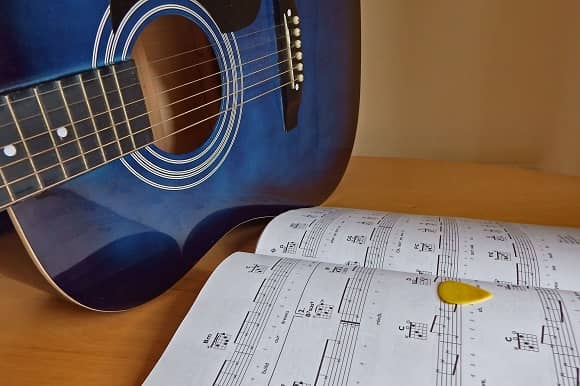Imagine picking up your guitar, hearing a tune, and strumming it out effortlessly. Without relying on the crutches of sheet music, learning to play guitar by ear can seem mystical and intimidating to beginners. But with dedication and practice, anyone can develop their musical ear and learn to play songs just by listening.
While many assume you need years of experience to achieve this, the secret often lies in sharpening your listening skills. Mastering this skill opens up a world of possibilities and allows guitarists to jam along with their favorite tracks. It also boosts creativity, improvisation skills, and overall musicianship.
This basic guide breaks down the fundamentals of playing guitar by ear in simple, easy-to-follow steps. With the right focus and persistence, these methods can take you from struggling to keep up with basic songs to effortlessly picking up intricate melodies and rhythms.
Ready to break free from the confines of conventional learning? So plug in and prepare to learn how to play guitar by ear, nurturing your inner musical sense.
The Basics of Listening
Before aspiring to play guitar by ear, it’s crucial to master the art of listening, distinguishing between passive and active listening.
Passive listening is what most do daily, hearing music while engaged in other tasks. But for learning guitar by ear, you need active listening, a conscious effort to understand sounds.
Using simple songs like “Happy Birthday” can be a starting point. Dive deep into the music, focusing not just on notes but also the tone, tempo, and emotion. Embrace mistakes; they’re stepping stones in your journey.
As you challenge yourself with more complex pieces, you’ll connect deeply with music’s essence.
Guitar Ear Training for Beginners
After understanding the art of active listening, it’s time to dive into specific techniques to learn to play guitar by ear. Learning a new song? Perfect! This is an excellent chance to flex and strengthen your “ear muscle”.
Unsure about where to start? Don’t stress! Let’s delve into seven straightforward steps that will guide you to play any song on guitar by ear, starting with the first and key step: honing your relative pitch.
1. Practice Your Relative Pitch
There are two key aural superpowers we often ascribe to great musicians: absolute and relative pitch. Having an absolute pitch (or defined as a perfect pitch) means having the ability to instantly recognize note by note of what is being played.
Having a relative pitch, instead, means having the ability to put notes and chords in relation to each other.
For example, if you hear a song and you can clearly identify the name of every single note, then you have an absolute pitch. If you recognize the relationships between chords and notes (such as progressions or intervals), even without being able to name them, then you have a pitch that is relative.
As far as the legend goes, absolute or perfect pitch is an innate skill. While it’s true that some people are naturally more inclined to develop this ability, we can all train to at least improve it. With relative pitch, however, you have no excuses: everyone knows you can master it through ear training.
Practicing your relative pitch will help you recognize the patterns in a melody, so you will instantly identify a certain interval or a specific chord progression. This is the first step to mapping out the melody you want to play.
2. Music Theory, Scales and Chords: Master the Basics
Another method to enhance your playing by ear is practicing basic scales and chords. This way, you will have two results.

Firstly, you will be more familiar with the fretboard (a significant aspect, especially for beginners). Secondly, you will train your musical ear by playing the same patterns repeatedly.
For example, if you practice pentatonic scales every day, you’ll be more likely to recognize them in a blues solo you want to learn. After all, music is often all about patterns!
By practicing music theory regularly, you’ll be able to figure out how notes make up each chord and how modes relate to scales, what various intervals sound like and how to play them anywhere on the neck.
It will allow you to avoid the usage of tab/tablature but improve your understanding of the sound and listening skills after a certain point.
If you need any help learning guitar or music theory, there are many great resources out there if you use Google and YouTube to search for free lessons, or can try out some courses and guitar theory books that give better aspects of theories.
3. Interval Training: Study the Intervals
Studying and practicing intervals is very important for musicians to develop their aural skills. By doing this training, you can train your ear and learn how to play musical instruments and songs by ear.
According to Wikipedia, “In music theory, an interval is the difference in pitch between two sounds”. It means the distance of the pitches from each other. You can notice this distance by the number of frets between notes on the same string.
There are two types of intervals: whole steps and half steps. Distant of one fret is called a half step or a semitone. The distance between two frets is known as a whole step or whole tone.
For example, in A minor scale, A B C D E F G A: A to B is two half steps apart. There is a bundle of these with names. But it truly matters when you hear the difference between those intervals and hear “two half steps apart” and such others regardless of what pitches were playing.
When you subjugate that along with knowledge of licks, it would be easier for you to amalgamate a solo in your head only by hearing them. But it would take a while to get habituated to the process.
For further clarification, check out the video on intervals here:

4. Identify Root Note
Practice listening and attempt to repeat what you hear. Listen to the phrase and try that on your guitar. Try with your favorite songs to trace the root note underlining each chord and hum along.
Hum a note and try to find it. If you can track the note, then hum second, then third, and go further. Next, find them as chords. It will be better as you practice more.
Soon you’ll hear the change coming before it even gets there. It’d take a while to urge it right since you are mostly focusing on blending the pitch of the note with the root note of the song.
5. Identify Melody
After root note identification, try with melody. Begin with simple melody lines and slowly proceed to more difficult ones.
Hum a melody that would need chord changing from one to another and try to detect each note on your instrument. After that, you can try easy 3-4 chord songs.
Here are a few steps you might take into consideration:
- Just listen to the song multiple times to concentrate on the rhythm and bass parts without playing guitar along. Bass parts are the hinge pin between the percussion and the chords.
- It is also helpful to define solos. Play the major or minor chords and power chords of the song with the bass line.
- Focus on the precise chord of the song and check out what chord voicing the guitar player is playing. Your musical sense to identify a majority of chords will develop over time.
- Slow the song down to half speed by using any media player to learn a solo. You will observe that solos or chords become more understandable at half speed. You will learn a vocabulary of licks, and it will help you to recognize those same licks used in different songs.

6. Sing it!
You might not be the best singer in the world. You might not have a very strong relative pitch either. It doesn’t matter. If you have the ability to play the guitar, chances are you have enough musicianship skills to reproduce a melody with your voice.
Some notes may be off, and the timbre might not be great, but you can probably sing a good 90% of a usual melody you have just heard. Even if you struggle with this ability, guess what? You can train to improve it by doing ear training exercises.

No matter what your level is, singing the melody you want to play can be a great way to find the right fret to tap. Let’s make a practical example.
Let’s assume you want to play “All You Need Is Love”. Grab your guitar and sing the first five notes of the chorus. Now, while singing, try to play them. Are you tapping the right frets?
This method instantly detects whether you are playing the wrong or the right notes. As straightforward as it is, it is golden for absolute beginners too.
7. Learn from Your Mistakes
Playing the guitar and song by ear requires a lot of training. Accept that, in the beginning, you won’t get it right. But instead of feeling discouraged, try to learn from your mistakes.
Do you recognize patterns in them? Are there any particular intervals you struggle to recognize? Do you need interval training? Any scale you need to practice more?
Great musicians keep studying and practicing every day and they never feel accomplished enough. As athletes do, they train their “muscles” every day, trying to fill their gaps. Get into this “trial and error” mindset as soon as you can and you will succeed.
Can You Learn Guitar by Ear?
Yes, you can. Today it is much easier to develop any skill with the help of a large amount of useful online and offline resources.
Before the era of YouTube and Online courses, there were many self-taught guitarists who could play major scale, minor, and pentatonic scales accurately without any formal training. They didn’t know any chord names and had zero ideas of formal scales but figured out different chords exactly by ear.
If you want to develop your ear, you’ll have to train it. As difficult as this may sound, anyone can improve their aural skills by doing some focused exercises.
It doesn’t matter whether you have some music theory knowledge or not. It doesn’t matter if you are a terrible singer, who doesn’t even dare to sing while showering. You can still adjust your pitch and improve your ear with some consistent work.
And you don’t have to wait until you achieve a certain skill level. From the very beginning of guitar learning, you can start developing this aural skill.
But keep in mind that if you cannot identify the difference between what you hear on the track and what you are playing on the guitar, then there is no good in trying to play songs by ear.
However, we suggest that one should take a combination learning approach. Guitar Ear training is as important as formal training.
Find a music teacher or guitar lesson platform where you’ll get to mix up music theory with learning songs and rhythm at the same time. That can go a long way toward keeping you interested.
Frequently Asked Questions
How long does it take to play guitar by ear?
It typically varies based on individual effort and consistency. First of all, you must do the hard work. Take action and exercise these recommended techniques regularly to see results. But be patient because this efficiency to hear and replicate takes time to develop.
The duration largely depends on your personal capability to practice consistently. Although playing by ear can be a bit of a challenge and does take time. But if you keep up to work at it, it will get better.
Is it possible for everyone to play by ear or is it a natural gift?
Yes, it is possible for everyone to play by ear. While some individuals might have a natural inclination or aptitude for it, playing by ear is a skill that can be developed with dedicated practice and training.
Many musicians who excel at this skill have honed their abilities over time. So, even if it doesn’t come naturally to you at first, with persistence and proper guidance, you can master the art of playing by ear.
Is playing by ear better than reading sheet music?
Neither is categorically better; they serve different purposes. Playing by ear offers flexibility and can be invaluable for improvisation while reading sheet music provides precision and a clear structure.
Both skills have their own advantages and many accomplished musicians incorporate both in their practices. Depending on the context and the musician’s goals, one might be preferred over the other.
Are there specific genres that are easier to start with when playing by ear?
Yes, simpler genres like folk or basic pop songs are often easier for beginners. These genres typically have straightforward chord progressions and melodies, making them more accessible for those starting to play by ear.
As one’s ear training for guitar advances, they can venture into more complex genres like jazz or classical. Starting with simpler tunes allows for a more gradual and successful introduction to playing by ear.
Final Words
To sum it up, you don’t necessarily have to be an advanced guitarist to play a song on your instrument by ear. Every step of the process involves skills you can develop through some solid ear training guitar exercises for beginners.
Practice your scales, focus on your ability to listen, and learn from your mistakes. Overall, develop a solid practice routine and stick with it. This way, you will obtain unexpected results.
About the Author
Gustavo is a music teacher and classical guitar player from Brazil, currently residing in Dublin, Ireland. He holds a graduate degree in Classical Guitar Performance from the Federal University of Pelotas. In 2020, Gustavo successfully completed a Master's degree in Sound Engineering from the Academy of Sound in Ireland.


